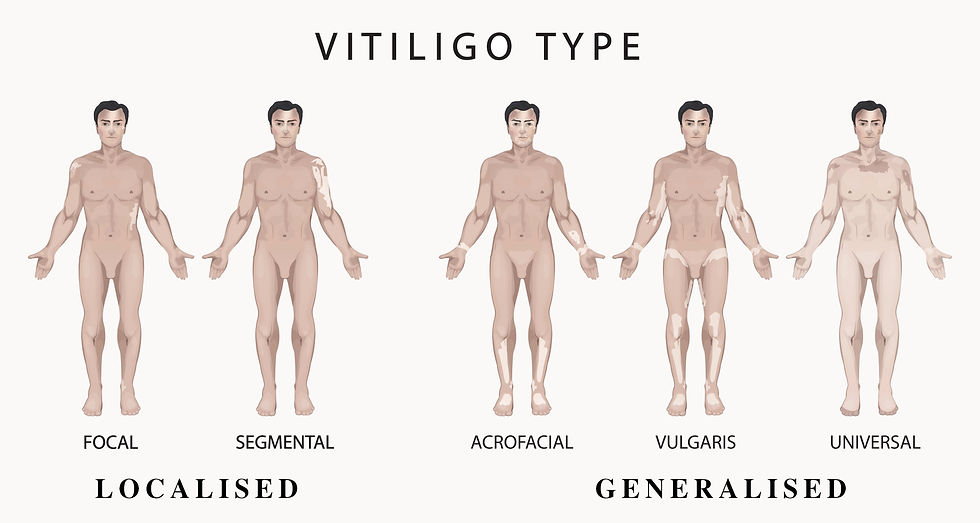VITILIGO - its ok!
- deepak rajan

- Sep 12, 2020
- 4 min read

What is Vitiligo?
Vitiligo (vit-ih-LIE-go) is a disease that causes loss of skin color in patches. The discolored areas usually get bigger with time. The condition can affect the skin on any part of the body. It can also affect hair and the inside of the mouth.
Normally, the color of hair and skin is determined by melanin. Vitiligo occurs when cells that produce melanin die or stop functioning. Vitiligo affects people of all skin types, but it may be more noticeable in people with darker skin. The condition is not life-threatening or contagious. It can be stressful or make you feel bad about yourself.
Treatment for vitiligo may restore color to the affected skin. But it doesn't prevent continued loss of skin color or a recurrence.
Vitiligo can be associated with:
Other autoimmune disorders such as thyroid disease (Hashimoto’s thyroiditis), Celiac disease, or alopecia areata
Family history of vitiligo
While vitiligo sometimes accompanies an underlying autoimmune disorder, it does not affect your overall health. That said, it does affect your appearance and can induce depression or negatively impact your self-esteem. You may experience a variety of emotions, including:
Embarrassment
Feeling self-conscious or insecure
Emotional and psychological issues
Anxiety, stress, and depression
Shame, sadness, or anger
Wanting to isolate and mood swings
Worry about how others will react and treat you
In particular, young people who often struggle to fit in and already feel self-conscious can experience social isolation and emotional problems due to vitiligo. This can lead to a wide range of emotions and impact one’s ability to go about normal daily activities and feel comfortable in social situations.


Coping with Vitiligo
Vitiligo can be hard to live with, but these tips can help you cope, take charge of your health, and maintain a positive attitude:
Find a dermatologist that you trust, who shows compassion, is willing to listen and take extra time with you, and has experience treating vitiligo
Learn as much as you can about the skin disease and associated autoimmune disorders
Take charge of your health and participate in making decisions about your care
Seek support from your doctor, other vitiligo patients, family, or a therapist
Manage stress and monitor your diet and lifestyle to address underlying autoimmune conditions
Wear sunscreen and protect your skin from the sun and artificial sources of UV light
Ask questions and follow treatment recommendations
Work with an aesthetician to find concealing products that make you feel more comfortable in your skin
Avoid tattoos or anything that can damage to your skin, which can cause a new patch of vitiligo to appear
Consider trying natural supplements including Ginkgo biloba, alpha-lipoic acid, folic acid, vitamin C and vitamin B-12 in addition to the treatments recommended by your dermatologist
Seek support from a mental health professional who works with people with depression and anxiety, particularly related to chronic illness
Talk to others who have vitiligo or other chronic skin conditions or autoimmune diseases.

Treatment options for Vitiligo
The goal of treatment in vitiligo is to decrease immune system activation within the skin. This can lead to regeneration of pigment cells. The stem cells that turn into melanocytes live in hair follicles so repigmentation typically presents around hair follicles. That said, areas without many hair follicles – lips, hands, knees – are harder to treat.
Types of treatments:
Non-Cultured Epidermal Melanocyte Transplant
Steroid Creams
Ultra violet therapy
Excimer laser
Depigmentation
Micro tattooing
Although research is ongoing, vitiligo has no cure. If you have vitiligo, you will have it for the rest of your life. Changes in pigmentation may be reversed or reduced through medical treatments, but some of these treatments can have serious side effects. The goal is learning to manage your symptoms and outbreaks – and your mindset – so you can live a fulfilling and active life!
FAQ’s
Here are some Faq’s about Vitiligo
How does Vitiligo Start?
When melanocytes stop producing melanin, then white patches start on the body. Vitiligo can start at any age but it predominantly appears between 20 and 30 years age group. It often appears on the body parts which are exposed to the sun and slowly spread throughout the body. The main reason for vitiligo is loss of pigmentation. It appears equally in both men and women.
Is Vitiligo Hereditary?
Vitiligo often occurs in different individuals in the same family. Almost 30 to 40% of people who are affected with vitiligo also have a family member in it. There are 5% chances that vitiligo can transfer from mother to baby. But still, there is no particular proof of how and why vitiligo is hereditary.
Can we stop Vitiligo spreading?
Yes, we can stop spreading vitiligo by immediate medication. After recognizing the white patches on the body immediately consult a dermatologist to stop spreading all over the body.
Can Vitiligo be caused by stress?
Vitiligo will not be caused by stress but, if melanocytes stop producing melanin then vitiligo occurs. There are some cases where vitiligo is increased by stress. If a person is already affected by vitiligo then the white patches will spread over the body if he is stressed.
Is milk not advisable for Vitiligo?
Many people believe that milk causes vitiligo or milk is not advisable for vitiligo patients. But it is just a myth. As milk contains calcium and nutrition levels that improve immunity in the body. So as milk is an essential diet for the people who are having vitiligo.
Hera Clinic offers a variety of medical, cosmetic, and surgical dermatology services. Our caring and experienced board-certified dermatologists will work with you to develop the best treatment plan. Contact Hera Clinic to learn more about vitiligo or schedule an appointment today!
We are here to help you with all your dermatology needs. Please reach out to us by calling 9500957697




Comments